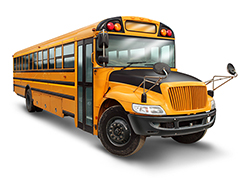Zoning in on Safety
In the School Zone.
By Ryu Hyejung.
After seeing the movie Dark Knight, I was quite amazed. One of the reasons is because a yellow school bus crashed through the lobby of a bank. The school bus was as solid as an armored vehicle, and it made me think about how concerned with student safety they are in America. Another time was when I was studying abroad in the U.S. in my 20s. I remember a day when a yellow bus came to a stop in the neighborhood, and suddenly it seemed like the whole world had stopped. All the cars waited until the last student on the bus had stepped onto the ground and headed to the backyard of his home. When the school bus stopped, all the cars stopped, too. Then I thought to myself, does that happen in my country? Actually, Korean road traffic law has similar rules to those of America. The text of Article 51 of the Road Law reads: “When a school bus has stopped with lights flashing, which indicates that children are getting on/off, any car behind the school bus and any car in a lane on the other side of the street must stop temporarily before proceeding slowly.”
Even though I love living in Gwangju and know many good people here, the picture on the road that we typically see every day, especially within school zones, is sometimes disappointing. I rarely see drivers make temporary stops and then drive on slowly – on either side of the street. I sometimes observe drivers driving on past the school bus when children are getting off of it after finishing daycare or study at an academy. An accident that happened on November 17 in Unam-dong, Buk-gu, was heartbreaking – a truck ran into a family of three siblings in a school zone, killing a two-year-old girl and injuring the other family members. Supposedly, the driver did not see the family when the vehicle started to move, even though it was at a crosswalk!
As a mother of two children, a seven-year-old girl and a five-year-old boy, I am acutely aware that school zone safety is a crucial issue that people should consider seriously. Whenever I help my children across the street safely or drop them off at daycare, I witness a lot of drivers who do not abide by the traffic rules, even though Min-sik’s Law, was passed last year by the National Assembly and has been in effect since May 25. Under “Min-sik’s Law,” which was named after Kim Min-sik, a nine-year-old boy who lost his life after being run over by a speeding car in a school zone, drivers are responsible for avoiding accidents in school zones. For example, if a driver injures a child under the age of 13 while driving in a school zone at a speed over the limit of 30 kilometers per hour, the driver will be given a minimum prison sentence of one year and up to 15 years, or be fined five to 30 million won. Drivers who kill a child of the same age will be sentenced to a minimum of three years in jail.

Some drivers say that if a child crosses the road suddenly between cars, they likely would not have a chance to notice the child coming, and it would not be easy for that driver then to avoid the accident. Those critics state that Min-sik’s Law is too harsh for drivers. For example, guilty drivers could have stricter punishments than those who commit crimes such as rape or assault. However, before demanding this law be amended, it is necessary for drivers to have a greater awareness of child behavior on the streets.
First, children, especially under the age of 13, tend to concentrate on just one object and run. So, this characteristic gives rise to accidents such as being run over. For instance, a child could run out into the street to get a ball while playing or cross the street toward their family on the other side of road without looking in both directions, left and right.
Second, children are unable to predict the speed and motion of cars. A car needs a minimum distance for braking and stopping. However, it is hard for children to estimate how quickly a moving car will come toward them. Also, illegally parked cars block both children’s and drivers’ views of oncoming traffic.
Therefore, as adults, we have to understand children’s behavior and be prepared when proceeding toward and through a school zone, no questions asked. Under the law, more fences and traffic lights along sidewalks will be installed, and surveillance cameras will be increased for safety. I hope children and parents can make it a priority to use school zones more safely, too. I think drivers and passengers have to roll up their sleeves together to prevent accidents involving children in school zones.
The Author
Ryu Hyejung is giving traffic safety courses for drivers. Also she is a mother of two children, and sometimes writes English articles about traveling and life.







